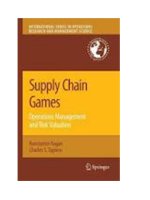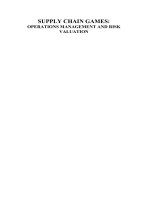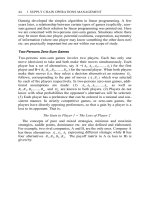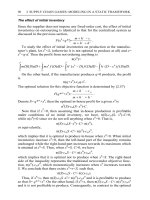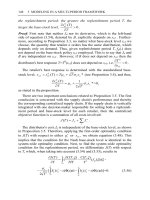Forcused operations management achieving more with existing resources RoNEN
Bạn đang xem bản rút gọn của tài liệu. Xem và tải ngay bản đầy đủ của tài liệu tại đây (2.15 MB, 467 trang )
John Wiley & Sons, Inc.
ffirs.indd i
8/18/07 4:24:54 PM
ffirs.indd iv
8/18/07 4:24:57 PM
John Wiley & Sons, Inc.
ffirs.indd i
8/18/07 4:24:54 PM
Copyright © 2008 by Boaz Ronen and Shimeon Pass. All rights reserved.
Published by John Wiley & Sons, Inc., Hoboken, New Jersey.
Published simultaneously in Canada.
No part of this publication may be reproduced, stored in a retrieval system, or transmitted
in any form or by any means, electronic, mechanical, photocopying, recording, scanning, or
otherwise, except as permitted under Section 107 or 108 of the 1976 United States Copyright
Act, without either the prior written permission of the Publisher, or authorization through
payment of the appropriate per-copy fee to the Copyright Clearance Center, Inc., 222
Rosewood Drive, Danvers, MA 01923, (978) 750–8400, fax (978) 646–8600, or on the web
at www.copyright.com. Requests to the Publisher for permission should be addressed to the
Permissions Department, John Wiley & Sons, Inc., 111 River Street, Hoboken, NJ 07030,
(201) 748–6011, fax (201) 748–6008, or online at />Limit of Liability/Disclaimer of Warranty: While the publisher and author have used their
best efforts in preparing this book, they make no representations or warranties with respect
to the accuracy or completeness of the contents of this book and specifically disclaim any
implied warranties of merchantability or fitness for a particular purpose. No warranty may
be created or extended by sales representatives or written sales materials. The advice and
strategies contained herein may not be suitable for your situation. You should consult
with a professional where appropriate. Neither the publisher nor author shall be liable for
any loss of profit or any other commercial damages, including but not limited to special,
incidental, consequential, or other damages.
For general information on our other products and services or for technical support, please
contact our Customer Care Department within the United States at (800) 762–2974,
outside the United States at (317) 572–3993 or fax (317) 572–4002.
Wiley also publishes its books in a variety of electronic formats. Some content that appears
in print may not be available in electronic books. For more information about Wiley
products, visit our web site at www.wiley.com.
Library of Congress Cataloging-in-Publication Data:
Ronen, Boaz.
Focused operations management: achieving more with existing resources/Boaz Ronen,
Shimeon Pass.
p. cm.
Includes bibliographical references.
ISBN 978-0-470-14510-4 (cloth)
1. Industrial management. 2. Production management. 3. Performance—Management.
I. Pass, Shimeon, 1947–II. Title.
HD31.R65 2008
658—dc22
2007012351
Printed in the United States of America.
10
ffirs.indd ii
9
8
7
6
5
4
3
2
1
8/18/07 4:24:56 PM
To our families
ffirs.indd iii
8/18/07 4:24:57 PM
ffirs.indd iv
8/18/07 4:24:57 PM
Contents
Preface
vii
Acknowledgments
xi
About the Authors
xiii
Part I: The Dynamic Management Environment
Chapter 1.
The Modern Business Environment
Chapter 2.
Principles of Management in the
Dynamic Environment
Chapter 3.
3
11
The Pareto Rule, the Focusing Table,
and the Focusing Matrix
27
Part II: New Approaches in Management
Chapter 4.
Managing the System by Its Constraints
Chapter 5.
Management by Constraints
in a Bottleneck Environment
Chapter 6.
43
71
Managing by Constraints When the
Market Is the Constraint
95
Chapter 7.
Focused Current Reality Tree
115
Chapter 8.
Resolving Managerial Conflicts
127
Chapter 9.
The Efficiencies Syndrome
137
v
ftoc.indd v
8/18/07 4:25:51 PM
vi
CONTENTS
Chapter 10.
Evils of Long Response Times
143
Chapter 11.
Reducing Response Times
157
Chapter 12.
The Complete Kit Concept
187
Chapter 13.
Performance Measures and
Managerial Control
Chapter 14.
201
The Effects of Fluctuations, Variability,
and Uncertainty on the System
215
Chapter 15.
Evils of Traditional Cost Accounting
233
Chapter 16.
Marketing, Costing, and Pricing Considerations
Chapter 17.
in Decision-Making Processes
241
Quality Management and Process Control
261
Part III: Strategy and Value Creation
Chapter 18.
Strategy, Positioning, and Focusing
281
Chapter 19.
Value Creation
307
Part IV: Applying the Focused Management
Approach
Chapter 20.
Value-Focused Project Management
Chapter 21.
Managing Research and
Development
Chapter 22.
345
369
The Focused Management
Approach in Logistics
395
Part V: Perspective and Implementation
Chapter 23.
ftoc.indd vi
Our Managerial Credo
421
References
435
Recommended Readings
439
Index
441
8/18/07 4:25:52 PM
Preface
How can a company double its value in less than 18 months? How
can an organization use existing resources to reduce the time to
market in the research and development department by 40 percent
and at the same time increase the product quality?
How can a company increase the throughput of the information
technology department by 20 percent using the same resources?
Why do traditional cost-accounting methods prevent firms
and other organizations from making better managerial decisions
in pricing, costing, investment justification, and make-or-buy
decisions? What are the alternatives that allow for better decision
making?
Why do performance measures sometimes undermine value
creation?
How can the removal of inexpensive bottlenecks easily increase
throughput, reduce response time, and increase quality?
Why does adding personnel and capital investments usually fail
to bring about improvements in service, in high-tech and in manufacturing organizations?
These topics and more are the theme of this book. The
information should be of great value to all executive and managerial personnel in every organization, including service, research
and development, manufacturing, health care, insurance, financial organizations, and government agencies. This book provides
vii
fpref.indd vii
8/18/07 4:26:14 PM
viii
PREFACE
practical knowledge and tools for people in managerial as well as
staff positions. Moreover, this book will be equally useful for nonprofit and for-profit organizations, in every sector, public or private,
service or industry.
This book explains how you can do much more with the same
resources in terms of throughput, response time, and quality by using
practical tools and techniques. We provide a systemic view and
touch on issues of performance measures, operations management,
quality, cost accounting, pricing, and, above all, value creation and
value enhancement. We hope that after reading this book, you will
be able to implement immediate actions resulting in improvement
in most performance measures of your organization.
Each chapter presents simple tools and concepts for more effective
management—highlighting the how aspect. These tools are accompanied by dozens of real-world examples of their successful use. Then
Chapter 19 helps to identify value drivers and guide decision makers
on where and when to implement various components of value creation. The final chapters enable managers to identify and deal first with
the most important and easily implementable topics.
We include the use of methods such as the theory of constraints
that yield fast improvement in systems such as service organizations,
high-tech companies, and industrial organizations. We demonstrate
how simple tools like the focusing table, the focusing matrix, the
Complete Kit concept, and Pareto analysis can increase throughput, reduce response time, and create value in every industry.
Based on our extensive experience in improving systems and
surveying the most recent improvements in dozens of organizations,
we show how the use of these methods can increase throughput and
reduce response time substantially while using existing resources.
This book is also useful as a text and reference in teaching
management and business administration, both for graduate and
undergraduate students.
Based on our broad experience in using and successfully implementing all of the components presented in the book in over
fpref.indd viii
8/18/07 4:26:14 PM
Preface
ix
120 organizations worldwide, this book reflects our rich teaching
experience with managers and students in various settings such as
masters’ of business administration (MBA) programs, executive
MBA programs, and health care management programs. Our experience encompasses Harvard University (School of Public Health),
Columbia University (Graduate School of Business), New York
University (Stern School of Business), Tel Aviv University (Faculty
of Management), Boston University (School of Management),
Ben-Gurion University of the Negev (Department of Industrial
Management, School of Management), in several Kellogg programs (Northwestern University) throughout the world, and in
SDA-Bocconi University in Milan, Italy.
Thousands of executives and students have actively implemented the methods described in the book after taking our courses
or participating in our workshops.
Our approach is application oriented, using new managerial
approaches. It is not the typical quantitative management book,
nor is it an organizational behavior one. It is mission or business
oriented (or both), targeted to achieve immediate and substantial
improvements in all types of organizations.
fpref.indd ix
8/18/07 4:26:15 PM
fpref.indd x
8/18/07 4:26:15 PM
Acknowledgments
We would like to acknowledge the valuable contributions of Shany
Karmy, Joseph S. Pliskin, Gali Ronen, Zvi Lieber, Nitza Geri,
Deborah Schindlar, and Eitan Sharoni.
xi
flast.indd xi
8/18/07 4:26:28 PM
flast.indd xii
8/18/07 4:26:29 PM
About the Authors
Boaz Ronen is a professor of technology management at Tel Aviv
University, Faculty of Management, the Leon Recanati Graduate
School of Business Administration. He holds a bachelor of science
degree in electronics engineering from the Technion, Haifa, and a
master’s of science degree and a doctorate in business administration from Tel Aviv University, Faculty of Management. Before his
academic career, he worked more than 10 years in the high-tech
industry. His main areas of interest are value enhancement and
improving performance. In his work, he combines value creation,
management of technology, the strategic and tactical aspects of the
theory of constraints, and advanced management philosophies.
Ronen has provided consultation services for numerous
corporations, health care organizations, and government agencies
worldwide. During the past 20 years, Ronen has led a team
that successfully implemented focused management, theory of
constraints, and advanced management practices of value creation
in dozens of industrial, high-tech, information technology, health
care, and service organizations.
Ronen teaches in the EMBA and MBA programs at Tel Aviv
University. He has received the rectors’ award for outstanding teaching. He was also a visiting professor at the schools of business of New
York University; Columbia University; the Kellogg-Bangkok program in Bangkok, Thailand; Stevens Institute of Technology; and
xiii
flast.indd xiii
8/18/07 4:26:29 PM
xiv
ABOUT THE AUTHORS
at SDA-Bocconi, Milan, Italy. He has published over a hundred
articles in leading academic and professional journals and
coauthored five books on value creation, focused management,
managerial decision making, healthcare management and cost
accounting.
Shimeon Pass, who is currently a partner in Focused Management Ltd., is an expert in applying the philosophy and tools of the
focused management methodology and the theory of constraints in
high technology, industrial, service, retail, banking, and nonprofit
organizations. He holds an MBA from the faculty of management,
Tel Aviv University; a MSc from the department of organic chemistry, the Weizmann Institute, Rehovot; and a BSc from the faculty
of chemistry, Technion, Haifa. While an executive at IBM, he specialized in software solutions marketing and the implementation of
advanced managerial methods to enterprise information systems.
He now specializes in applying focused management and theory
of constraint practices in the management of research and development organizations and project management. Pass coauthored
Focused Operations Management for Health Services Organization with Boaz Ronen and Joseph S. Pliskin. His papers on value
creation and performance improvement have been published in
leading practice and academic journals.
flast.indd xiv
8/18/07 4:26:29 PM
Part I
The Dynamic Management
Environment
c01.indd 1
8/18/07 4:40:49 PM
c01.indd 2
8/18/07 4:40:49 PM
1
The Modern Business Environment
During the past two decades, the business environment in many sectors has been characterized by rapid changes. The main revolution
has been the transition from a sellers’ market to a buyers’ market.
The sellers’ market, which was rather common in the past, refers to
a somewhat monopolistic business environment where the supplier
or service provider dictated the dimensions of a transaction:
• Price: Usually determined by a “cost-plus” approach
where the customer is charged the full costs of the services rendered plus a “reasonable profit.”
• Response time: Determined by the supplier (“We are
doing our best and we are really trying.”).
• Quality: Determined by the service/product provider (“We
are doing the best we can under the circumstances.”).
• Performance: Dictated to the customer (“We know
better than the customers what they need. We are the
professionals.”).
From a Sellers’ Market to a Buyers’ Market
Today’s business environment is that of a buyers’ market. This
trend is the result of international transitions and macroeconomic,
3
c01.indd 3
8/18/07 4:40:49 PM
4
FOCUSED OPERATIONS MANAGEMENT
technological, political, and social changes. This environment is
characterized by:
• Globalization of the world economy
• Fierce competition among organizations within and
across countries
• Global excess capacities in production, services, and in
some areas of development
• Using new managerial approaches
• Availability and accessibility of data and
knowledge
• Timely availability of materials and services
• Ease of global travel and conveyance
• Adoption of advanced technologies for production and
development
• Extensive use of advanced computers and information
systems
• The extensive use of cheap and rapid communication
technology
• Shortened life cycles of products and services
• Democratization and customer empowerment
Globalization—The Small Global Village
The world is gradually becoming a world without borders. In most
regions, particularly in the Western countries, people can travel
freely without the need for entry visas. Similarly, customs and tariffs on goods transferred across borders have been reduced or totally
c01.indd 4
8/18/07 4:40:49 PM
The Modern Business Environment
5
eliminated. Travel between countries is easy, fast, and cheap,
whether be it people, merchandise, or materials.
In the past decade, we witnessed a trend in the formation of
multinational firms. Successful companies acquire partial or full
ownership of firms in other countries, thus obtaining an advantage
of access to additional markets and diversification of the product
line of the parent company. Firms engage in international cooperation with foreign firms, resulting in mutual benefits. Many companies have excess capacity in production and services, and it is essential
to find additional market channels and better congruence with
customers of the various world markets.
Communication has become global. Many television programs,
radio broadcasts, and written media are readily transportable to
other parts of the world. People in remote areas watch, for better or
worse, the same television programs, laugh at the same jokes, and
are exposed to messages of democracy and an open world.
The globalization trend is not coincidental. It is strongly
affected by the end of global wars and the opening of borders,
resulting in a shift of resources from military industries to civilian
ones, including services such as health care and education, as well
as privatization of economic activity. The world has opened up
and we are witnessing a desire for individual and social welfare,
customer empowerment, and awareness of environmental quality.
The enhanced openness has made technological and managerial
knowledge accessible to all.
A leading company in the field of electronic measurement equipment identified a short lead time as a competitive edge with
respect to their (potential) customers. By cutting their lead time
from the industry standard of three months to two weeks, the company was able to deliver a variety of products to the customers in a
(continued )
c01.indd 5
8/18/07 4:40:50 PM
6
FOCUSED OPERATIONS MANAGEMENT
short lead time. As a result, they became the industry’s leader. Using
the cash generated, they acquired a British company, a French
company, and later a Chinese company and became a global
company competing worldwide.
A buyers’ market is characterized by:
A fierce local/global competition
Excess capacity
Short life cycle of services/products
High uncertainty
Mature and demanding customers
Antitrust regulations
High pressure from shareholders
In a buyers’ market the customer or the market determines the:
• Price: Determined by the market. The manufacturer or
service provider must adjust to market prices to survive.
Customers are not interested in how much it costs the
manufacturer or the service provider. The market dictates the price, leaving the manufacturer or the service
provider with the cruel choice of adjusting to market
prices or disappearing. In some cases, superior quality,
unusual features, or performance can improve the price
by 10 percent to 15 percent or more.
• Response time: Determined by the best response time in
the market. For example, for film and photo developing, when one-hour developing emerged, stores with a
lead time of a full day had no chance of survival.
• Quality: Determined by the best quality existing in
the market. For example, automobiles and electronic
equipment are compared to Japanese products that provide
c01.indd 6
8/18/07 4:40:50 PM
The Modern Business Environment
7
the standard for quality. Even lower prices cannot provide
market survival for those who do not perform to standards.
• Performance: Customers determine their wishes and needs.
The process of globalization and the shift from a sellers’ market to a buyers’ market also caused shareholders to put pressure
on management. A manager is evaluated by different criteria than
in the past. He is dealing with shareholders who will not accept
excuses, know alternative solutions to problems, and are aware of
and demand new managerial approaches and up-to-date managerial standards. Globalization and strong competition result in many
firms coping with survival.
In not-for-profit organizations, including government agencies and hospitals, there has been an increase in demand for services
on the one hand, and budget reductions on the other. This situation results in much higher pressures on management. Using new
managerial approaches and philosophies enables management to
extract additional output from their organizations without increasing resources. For example, in one major hospital, operating room
output has increased by 20 percent with the same resources and
with better clinical and service quality.
The Remedy—Adoption of New Managerial
Approaches
Advanced technology, professional personnel, and powerful information systems do not guarantee survival in the highly competitive market. They are perhaps necessary or supportive conditions,
but definitely not sufficient. The main determinant in the ability
of the organization to survive the competition is the adoption of
advanced managerial approaches that are compatible with the new
business environment.
Recently, new managerial approaches have been developed
and successfully implemented in many organizations. In many
c01.indd 7
8/18/07 4:40:50 PM
8
FOCUSED OPERATIONS MANAGEMENT
instances, managerial decision-making processes have changed.
The foundation for the development of these new approaches is
the desire to be compatible with a new business environment and
to engage relevant value drivers to improve and enhance the value
of these organizations.
Organizations realize that in order to succeed in the global
competitive environment, it is not enough to revert to technological innovation or to use cheaper resources and materials. It is
essential to manage differently. New managerial approaches result
in enhancing the value of the organization.
Value enhancement: Increasing the value of the organization to its owners usually goes hand in hand with value
creation for its workers and to the community.
The new managerial approaches have several characteristics in
common:
• They are based on common sense.
• They evolved out of practice; only later did they
receive academic and scientific validation.
• They are simple and use the KISS (“Keep It Simple,
Stupid”) approach.
• They break down the myth of the input-output model
(Figure 1.1).
Input
System
Output
Figure 1.1 The Input-Output Model
c01.indd 8
8/18/07 4:40:50 PM


